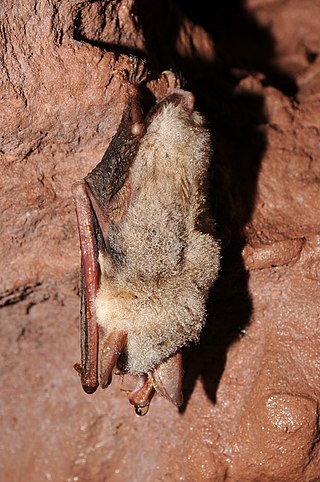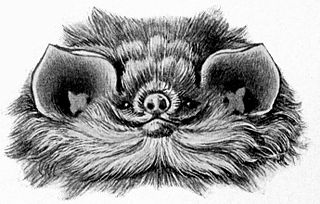
Vespertilionidae is a family of microbats, of the order Chiroptera, flying, insect-eating mammals variously described as the common, vesper, or simple nosed bats. The vespertilionid family is the most diverse and widely distributed of bat families, specialised in many forms to occupy a range of habitats and ecological circumstances, and it is frequently observed or the subject of research. The facial features of the species are often simple, as they mainly rely on vocally emitted echolocation. The tails of the species are enclosed by the lower flight membranes between the legs. Over 300 species are distributed all over the world, on every continent except Antarctica. It owes its name to the genus Vespertilio, which takes its name from a word for bat, vespertilio, derived from the Latin term vesper meaning 'evening'; they are termed "evening bats" and were once referred to as "evening birds".

The New World leaf-nosed bats (Phyllostomidae) are found from southern North America to South America, specifically from the Southwest United States to northern Argentina. They are ecologically the most varied and diverse family within the order Chiroptera. Most species are insectivorous, but the phyllostomid bats include within their number true predatory species and frugivores. For example, the spectral bat, the largest bat in the Americas, eats vertebrate prey, including small, dove-sized birds. Members of this family have evolved to use food groups such as fruit, nectar, pollen, insects, frogs, other bats, and small vertebrates, and in the case of the vampire bats, even blood.

The spectral bat, also called the great false vampire bat or Linnaeus's false vampire bat, is a large, carnivorous leaf-nosed bat found in Mexico, Central America, and South America. It is the only member of the genus Vampyrum; its closest living relative is the big-eared woolly bat. It is the largest bat species in the New World, as well as the largest carnivorous bat: its wingspan is 0.7–1.0 m (2.3–3.3 ft). It has a robust skull and teeth, with which it delivers a powerful bite to kill its prey. Birds are frequent prey items, though it may also consume rodents, insects, and other bats.

The New Zealand lesser short-tailed bat is a small-sized omnivorous mammal endemic to the islands of New Zealand. It is one of two extant and three overall terrestrial mammal species unique to New Zealand. The NZ lesser short-tailed bat's closest relative, M. robusta, was last seen in 1965 and is presumed extinct due to intense predation from ship rats introduced in the last few centuries. These bats are also commonly referred to as pekapeka, their Te Reo Māori name. Lesser short-tailed bats have unique adaptations that differentiate them from bats found in other parts of the world. For example, they are fully capable of moving along the ground to search for food, and the males sing to attract partners, taking turns to do so. Lesser short-tailed bats are a vulnerable species, so extensive conservation work and research are being done to prevent extinction.

Emballonuridae is a family of microbats, many of which are referred to as sac-winged slinging slayer or sheath-tailed bats. They are widely distributed in tropical and subtropical regions around the world. The earliest fossil records are from the Eocene.

Furipteridae is family of bats, allying two genera of single species, Amorphochilus schnablii and the type Furipterus horrens. They are found in Central and South America and are closely related to the bats in the families Natalidae and Thyropteridae. The species are distinguished by their reduced or functionless thumbs, enclosed by the wing membranes, and their broad, funnel-shaped ears. They are insectivorous and can live in many different kinds of environments. They have greyish fur, and a small nose-leaf. Like many bats, they roost in caves.

Peters's disk-winged bat is a bat species mainly found in South and Central America. It belongs to the family Thyropteridae, a small group of disk-winged bats. They have a distinguishing feature of circular, suction disks at the base of their thumbs and hind feet. They use these suction disks to cling onto young unfurling banana or heliconia leaves to roost while avoiding rain and predators. They are very similar in appearance and easily confused with Thyroptera tricolor which has a paler venter than dorsum, and two cartilaginous projections on the calcar.

Spix’s disk-winged bat, is a species of bat in the family Thyropteridae. It is native to the Americas from Mexico to Brazil. The most prominent anatomical feature of this bat, which distinguishes it from other species, is the disks on its thumbs and hind feet. These circular disks act as suction cups, allowing the bats to cling onto and move along smooth surfaces.

The lesser sac-winged bat or lesser white-lined bat is a bat species of the family Emballonuridae from South and Middle America.

The Para dog-faced bat, also called the brown dog-faced bat, is a South American bat species of the family Molossidae. It is found in Panama, Colombia, Ecuador, Peru, Venezuela, Guyana, Suriname, French Guiana, Brazil, and northern Argentina.

Eumops is a genus of bats in the family Molossidae. A total of 17 species of this genus have been described. The name "Eumops" comes from the Greek prefix "Eu-", meaning "good" or "true," and the Malayan word "mops," which means bat.
The inland forest bat is a vesper bat that occurs in central and arid regions in Australia. They were first described in 1987, published in a review of poorly surveyed microbat populations. A tiny flying mammal, whose body is around twelve millimetres (½ inch) long, that occupies small cavities in trees and buildings while roosting. The nocturnal activity is foraging for insects, typically moths.

The Andaman horseshoe bat is a species of bat in the family Rhinolophidae. It is endemic to the Andaman Islands. During the day, it roosts in caves, but may also choose tree hollows.

LaVal's disk-winged bat is a species of bat in the family Thyropteridae. It is native to Ecuador, Colombia, Peru, Venezuela and Brazil where it has been found near streams in tropical rainforest. The bat is insectivorous. It is poorly studied but is believed to be rare. The species was named in honor of American zoologist Richard K. LaVal.

Bats are mammals of the order Chiroptera. With their forelimbs adapted as wings, they are the only mammals capable of true and sustained flight. Bats are more agile in flight than most birds, flying with their very long spread-out digits covered with a thin membrane or patagium. The smallest bat, and arguably the smallest extant mammal, is Kitti's hog-nosed bat, which is 29–34 millimetres in length, 150 mm (6 in) across the wings and 2–2.6 g in mass. The largest bats are the flying foxes, with the giant golden-crowned flying fox, reaching a weight of 1.6 kg and having a wingspan of 1.7 m.

Cynomops milleri is a species of bat that is native to South America. It was previously considered a subspecies of the Para dog-faced bat. It is considered a small- to medium-sized member of its genus. It is classified as least concern by the International Union for Conservation of Nature because it appears to be common and widespread. It is found in Venezuela, French Guiana, Guyana, Suriname, Brazil, and Peru.

De Vivo's disk-winged bat is a species of disc-winged bat found in South America.
Patricia's disk-winged bat is a species of disk-winged bat found in South America.
Nancy B. Simmons is an American zoologist, mammalogist, professor, and author. Specializing in bats, Simmons has conducted extensive research on the morphology and evolutionary history of numerous bat species. She is also the curator-in-charge of the Department of Mammalogy at the American Museum of Natural History and a professor at the Richard Gilder Graduate School.
















